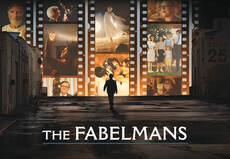
The Fabelmans
Expression through the arts is perhaps the most cathartic way of dealing with whatever slings and arrows life may hurl. If one cannot fully utilize therapy to bring about calm, one is likely to pick up a pen, or paintbrush and expel his or her feelings upon paper or canvas. Steven Spielberg chose to pick up a movie camera, and, boy, are we ever glad that he did. His list of films seems almost endless: “Jaws,” “Schindler’s List,” “Raiders of the Lost Ark,” “E.T” “Jurassic Park,” “Munich,” “Lincoln,” etc. These films have conflicts, bold characters, and cinematic endings of magnificent proportions. While making such classics, was Spielberg troubled?
His latest directorial film is “The Fabelmans,” and it’s his own autobiography. The film stars Paul Dano and Michelle Williams as Burt and Mitzi Fabelman, parents of a slightly dysfunctional Jewish family from New Jersey. They take their oldest child, Sammy (obviously a young Spielberg), to his first film, DeMille’s “Greatest Show On Earth,” which leaves such an impression that the boy is forever crashing his toy train set while filming with his 8mm camera.
Burt is a pre-Silicon Valley computer genius in the 1950s, and the family moves across the country, with stops in Phoenix and Northern California. Their moves from predominately Jewish neighborhoods to more ethnically absent neighborhoods weigh heavy on the entire family, especially for young Sammy, whose camera tends to capture the truth no matter how painful it really is.
Virtually every scene in the film is a wink and nod to Spielberg classics, and these references will be evident to rabid Spielberg fans. “The Fabelmans” is a personal love letter from Spielberg to the world, and for those who are interested in what makes a filmmaker tick, you won’t find a better picture to see than this.
The Banshees of Inisherin
Academy Award winning director Martin McDonagh delivers one of the more awkward (yet seriously funny) “dramedies” in “The Banshees of Inisherin.” Set in the 1920s, the film stars Brendan Gleeson and Colin Farrell as former best friends Colm and Padraic, who live on one of the tiniest islands in all of Ireland. McDonagh delivers a cinematographer’s dream in that almost every outdoor shot is made from pure Emerald Isle perfection, yet not all is rosy there on Inisherin. The tavern fiddler Colm has a midlife crisis and suddenly cannot stand to be in the mundane presence of Padraic.
The midlife severance crisis between older men is a film topic that is rarely seen, and Martin, who also wrote this screenplay, has done a bang-up job in bringing out the blackest of comedy tropes to get such an underutilized plot some attention. The film is confidently Irish in its purpose, but comes across to American audiences as both unique and refreshing. Outdoing himself again, Martin and the film’s actors should reap some nominations come award season time.
Expression through the arts is perhaps the most cathartic way of dealing with whatever slings and arrows life may hurl. If one cannot fully utilize therapy to bring about calm, one is likely to pick up a pen, or paintbrush and expel his or her feelings upon paper or canvas. Steven Spielberg chose to pick up a movie camera, and, boy, are we ever glad that he did. His list of films seems almost endless: “Jaws,” “Schindler’s List,” “Raiders of the Lost Ark,” “E.T” “Jurassic Park,” “Munich,” “Lincoln,” etc. These films have conflicts, bold characters, and cinematic endings of magnificent proportions. While making such classics, was Spielberg troubled?
His latest directorial film is “The Fabelmans,” and it’s his own autobiography. The film stars Paul Dano and Michelle Williams as Burt and Mitzi Fabelman, parents of a slightly dysfunctional Jewish family from New Jersey. They take their oldest child, Sammy (obviously a young Spielberg), to his first film, DeMille’s “Greatest Show On Earth,” which leaves such an impression that the boy is forever crashing his toy train set while filming with his 8mm camera.
Burt is a pre-Silicon Valley computer genius in the 1950s, and the family moves across the country, with stops in Phoenix and Northern California. Their moves from predominately Jewish neighborhoods to more ethnically absent neighborhoods weigh heavy on the entire family, especially for young Sammy, whose camera tends to capture the truth no matter how painful it really is.
Virtually every scene in the film is a wink and nod to Spielberg classics, and these references will be evident to rabid Spielberg fans. “The Fabelmans” is a personal love letter from Spielberg to the world, and for those who are interested in what makes a filmmaker tick, you won’t find a better picture to see than this.
The Banshees of Inisherin
Academy Award winning director Martin McDonagh delivers one of the more awkward (yet seriously funny) “dramedies” in “The Banshees of Inisherin.” Set in the 1920s, the film stars Brendan Gleeson and Colin Farrell as former best friends Colm and Padraic, who live on one of the tiniest islands in all of Ireland. McDonagh delivers a cinematographer’s dream in that almost every outdoor shot is made from pure Emerald Isle perfection, yet not all is rosy there on Inisherin. The tavern fiddler Colm has a midlife crisis and suddenly cannot stand to be in the mundane presence of Padraic.
The midlife severance crisis between older men is a film topic that is rarely seen, and Martin, who also wrote this screenplay, has done a bang-up job in bringing out the blackest of comedy tropes to get such an underutilized plot some attention. The film is confidently Irish in its purpose, but comes across to American audiences as both unique and refreshing. Outdoing himself again, Martin and the film’s actors should reap some nominations come award season time.


 RSS Feed
RSS Feed